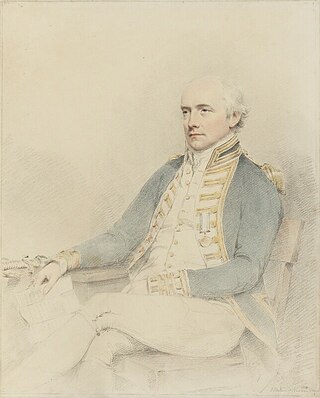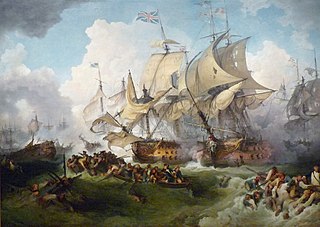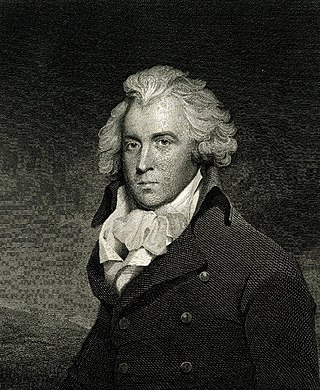
Richard Brinsley Butler Sheridan was an Anglo-Irish playwright, writer and Whig politician who sat in the British House of Commons from 1780 to 1812, representing the constituencies of Stafford, Westminster and Ilchester. The owner of the Theatre Royal, Drury Lane in London, he wrote several prominent plays such as The Rivals (1775), The Duenna (1775), The School for Scandal (1777) and A Trip to Scarborough (1777). He served as Treasurer of the Navy from 1806 to 1807. Sheridan died in 1816 and was buried at Poets' Corner in Westminster Abbey. His plays remain a central part of the Western canon and are regularly performed around the world.

Admiral of the Fleet Richard Howe, 1st Earl Howe,, was a British naval officer. After serving throughout the War of the Austrian Succession, he gained a reputation for his role in amphibious operations against the French coast as part of Britain's policy of naval descents during the Seven Years' War. He also took part, as a naval captain, in the decisive British naval victory at the Battle of Quiberon Bay in November 1759.

The Rivals is a comedy of manners by Richard Brinsley Sheridan in five acts which was first performed at Covent Garden Theatre on 17 January 1775. The story has been updated frequently, including a 1935 musical and a 1958 episode of the TV series Maverick starring James Garner and Roger Moore, with attribution.

Admiral of the Fleet James Gambier, 1st Baron Gambier, was a Royal Navy officer. After seeing action at the capture of Charleston during the American Revolutionary War, he saw action again, as captain of the third-rate HMS Defence, at the battle of the Glorious First of June in 1794, during the French Revolutionary Wars, gaining the distinction of commanding the first ship to break through the enemy line.

In naval warfare during the Age of Sail, raking fire was cannon fire directed parallel to the long axis of an enemy ship from ahead or astern. Although each shot was directed against a smaller profile compared to firing at the target ship's broadside and thus more likely to miss the target ship to one side or the other, an individual cannon shot that hit would pass through more of the ship, thereby increasing damage to the hull, sails, cannon and crew. In addition, the targeted ship would have fewer guns able to return fire. Historically, a stern rake tended to be more damaging than a bow rake because the shots were less likely to be deflected by the curved and strengthened bow, and because disabling the exposed rudder at the stern would render the target unable to steer and thus manoeuvre. However, achieving a position to rake a single enemy ship was usually very difficult unless the opponent was unable to manoeuvre due to damage to its sails or rudder; it was easier if the enemy ship was required to maintain its position in a line of battle.

Admiral of the Fleet Sir William Parker, 1st Baronet, GCB, was a Royal Navy officer. As a captain's servant he took part in the Battle of The Glorious First of June in June 1794 during the French Revolutionary Wars and, as a captain, he participated in the capture of the French ships Marengo and Belle Poule at the action of 13 March 1806 during the Napoleonic Wars. He was detached on an independent command on the Tagus in September 1831 with a mission to protect British interests during the Portuguese Civil War. As Commander-in-chief of the East Indies and China Station, he provided naval support at various actions between 1841 and 1842 during the First Opium War. Appointed Commander-in-Chief, Mediterranean Fleet in February 1845, he was briefly First Naval Lord in the First Russell ministry from 13 July 1846 to 24 July 1846 but gave up the role due to ill health before returning to his command with the Mediterranean Fleet.

The Naval Gold Medal was awarded between 1793 and 1815 to senior officers of the Royal Navy for specified actions.
Events from the year 1779 in Great Britain.

The Glorious First of June of 1794 was the first and largest naval action between the French and British fleets during the French Revolutionary Wars. The action was fought over 400 miles (640 km) west of Ushant, the most western point on Brittany in France, deep in the Atlantic Ocean. The British fleet under Lord Howe was attempting to defeat a French fleet under Villaret de Joyeuse which was in turn attempting to lure Howe away from a grain convoy destined for France from the United States. The future of the French Revolution depended on this 117-strong convoy, which would save France from famine if it arrived safely. Ultimately, both admirals were successful in their ambitions; Howe defeated Villaret in open battle and sunk or captured seven of his ships. Villaret managed to occupy Howe for long enough and inflict sufficient damage that the convoy escaped unscathed.

Impétueux was a Téméraire class 74-gun ship of the line of the French Navy.
Sceptre was a 74-gun ship of the line of the French Navy. Built under the Ancien Régime, she took part in the naval operations in the American Revolutionary War. At the Revolution, she took part in the main actions of the French Revolutionary Wars, notably the so-called Glorious First of June and in Bruix' expedition of 1799. Showing her age by the rise of the First French Empire, she was hulked and eventually broken up.

Lord Howe's Action, or the Glorious First of June is a 1795 painting by Philippe-Jacques de Loutherbourg of the victory of British naval forces under Lord Howe over a French force led by Louis Thomas Villaret de Joyeuse on the Glorious First of June 1794. After time in the Royal Collection of George IV, it is in the collection of the National Maritime Museum and on display in the ground floor of its Queen's House.

Patriote was a Téméraire class 74-gun ship of the line of the French Navy. She was one of the French ships which had their hull doubled with copper.

HMS Sans Pareil("Without Equal") was an 80-gun third rate ship of the line of the Royal Navy. She was formerly the French ship Sans Pareil, but was captured in 1794 and spent the rest of her career in service with the British.

"To Sheridan" or "To Richard Brinsley Sheridan" was written by Samuel Taylor Coleridge and published in the 29 January 1795 Morning Chronicle. As the last poem running as part of the Sonnets on Eminent Characters series, it describes Coleridge's appreciation of Richard Brinsley Sheridan and his theatre talents. Coleridge, unlike most, preferred Sheridan's somber works over his comedies and emphasizes them within the poem. Coleridge also respects Sheridan's political actions.
HMS Incendiary was an 8-gun fireship of the Royal Navy. She was present at a number of major battles during the French Revolutionary Wars, and captured, or participated in the capture, of several armed vessels. In January 1801 she was in the Gulf of Cadiz where she encountered Admiral Ganteume's squadron. The 80-gun French Navy ship of the line Indivisible received the credit for the actual capture.

Joseph Richardson (1755–1803) was an English author and politician.
Newton Ogle (1726–1804) was a Church of England clergyman and member of the landowning Ogle family. The son of Nathaniel Ogle and Elizabeth Newton, he served as a prebendary of Durham Cathedral and from 1769 to 1804 as Dean of Winchester. His wife Susanna Thomas was daughter of John Thomas, Bishop of Winchester.
The 1795 food riots are known as the revolt of the housewives, a term coined by John Lawrence Hammond and Barbara Hammond for a series of food riots and disturbances in England in 1795. They arose out of exceptional food scarcity. Women played conspicuous roles in the riots.

William Barrymore was a British stage actor. Originally from Taunton he was part of a company of strolling players in the West Country, and was acting at Plymouth in 1780. He first appeared at the Theatre Royal, Drury Lane in 1782, under the management of Richard Sheridan, and became a long-standing member of the company. He is also the namesake of the famed Barrymore family.















